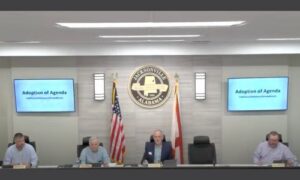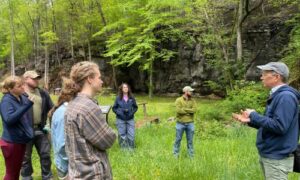
December 13, 2021
Kimberly O’Dell
If you are driving down Quintard Avenue through Anniston and stop at the 11th Street intersection you will notice a statue of a stately gentlemen dressed in 19th Century garb looking over the intersection. That statue, listed on the National Historic Register, depicts Samuel Noble the founder of Anniston. The statue was funded by the citizens of Anniston through the Samuel Noble Monument Association and designed by Durham and Company in Charlotte, NC. It was sculpted by an unknown Italian sculptor. The monument is in three parts: the granite base with Noble’s name engraved, a sculpture of bars meant to resemble pig iron which was Noble’s profession, and finally the man himself in white marble sitting on a granite pedestal. Originally, the monument had a cast iron fence around it for many years until Quintard Avenue was widened and incorporated into Highway 21.
 This tribute from the people of Anniston was dedicated in a June 1895 ceremony. A large procession, reported to consist of more than 5,000 people, wound its way through the main streets of Anniston to the 11th Street and Quintard Avenue intersection for the presentation. Elizabeth Daves Roberts, born a few months before her grandfather’s death, unveiled the statue in front of the monument association, mayor and city council, as well as other dignitaries. Since that June day, Samuel Noble has stood watch over his city.
This tribute from the people of Anniston was dedicated in a June 1895 ceremony. A large procession, reported to consist of more than 5,000 people, wound its way through the main streets of Anniston to the 11th Street and Quintard Avenue intersection for the presentation. Elizabeth Daves Roberts, born a few months before her grandfather’s death, unveiled the statue in front of the monument association, mayor and city council, as well as other dignitaries. Since that June day, Samuel Noble has stood watch over his city.
So, who was Samuel Noble, the man? Noble was the fourth child and third son of James Sr. and Jenifer (nee Ward) Noble. Samuel, born on November 22, 1834, in Cornwall, England was christened on Valentine’s Day 1835. James Sr. decided to leave Cornwall, a tin and copper mining center, and immigrate to the United States in 1837. He settled his family first in Pottsville, PA then in Reading, PA where he engaged in the iron industry. Samuel and his siblings, of which there were ultimately ten who survived to adulthood, were enrolled in the Pennsylvania school system. While in Pennsylvania, James learned the iron trade and all of his sons including Samuel, who trained as a boiler maker, followed the same career path.
As an adult Samuel and the entire Noble family moved to Rome, Georgia around 1855. James Sr. established a rolling mill and foundry in Rome called the Noble Iron Works. The business became extremely profitable. Samuel set his mind to learning about the iron ore deposits in Georgia and North Alabama.
Samuel’s life changed considerably after moving to Georgia. On July 10, 1861, Samuel and Matilda Christine Stoeckel were married by Charles Todd Quintard, later Episcopal Bishop of Tennessee, at St. Peter’s Episcopal Church in Rome Georgia. The newlyweds settled in Rome, GA. While Samuel ran operations at the Noble Iron Works, Matilda kept house and tended to their four children: Kate, Addie, Josephine and Samuel E.
During the Civil War, the Noble Iron Works built munitions for the Confederacy. In the 1860s. Samuel was in charge of building the family’s new iron furnace in Cherokee County, Alabama. The Cornwall Furnace, was Samuel’s project from start to finish. When Cornwall was ready for operation, Samuel became the superintendent of operation. The Union Army burned both the Cornwall Furnace and the main Noble Iron Works in Rome in 1864.
After the war, the Noble family wanted to expand their iron works and find a new source for iron. Samuel was aware of an area in Northeast Alabama populated by dense pine forests and a fresh supply of iron. While Samuel wanted to build an iron foundry on the site, he lacked the financial means to accomplish his dream. As it would happen, in 1872, Samuel was on a business trip to Charleston, SC where he met General Daniel Tyler in the South Carolina Railroad office of Tyler’s son, Alfred. General Tyler agreed to help finance Noble’s venture. The men organized the Woodstock Iron Company and build it on the Northeast Alabama property known as Pine Ankle. The iron furnace was operational in 1873 and for the next ten years Samuel nurtured his “model city”. Noble’s dream was to create a post-war utopian city. Eventually, a textile mill was added to employ the wives and children of the iron workers. In 1883, Noble made the decision to open his town to the public. He decided to name his new town “Annie’s Town” after General Tyler’s daughter-in-law Annie Tyler. Eventually, the name was corrupted to be Anniston.
Noble’s vision for Anniston was grand. He brought craftsmen from across Europe to build his city. He hired a gardener from Paris’ Tuileries Gardens to create a botanical garden on Quintard Avenue. He sent recruiters to Europe and other parts of the United States to bring back new settlers as well as industrialists who could finance the building of Noble’s Model City.
Anniston was fortunate to have Noble’s steady hand guiding her for the first six years until a fateful day in August. On August 10, 1888, Samuel was surveying a railcar with the latest products from the iron foundry. The railcar was located in Oxford so Noble decided to walk to his home on Christine Circle rather than wait for a driver. It was a hot day so Noble stopped by Dr. Wikle’s Drug Store for a tall glass of Ice-cold milk. After refreshing himself, Noble continued walking home. When he arrived home, he ate a large dinner that night which resulted in an attack of indigestion. Noble died of stress and severe gastroenteritis on August 13, 1888. The entire town went into morning. His funeral was held at Grace Episcopal Church followed by burial in Hillside Cemetery both just blocks from his home.
Samuel Noble, in the few short years he guided Anniston, left a large legacy. He built both a boy’s school and girl’s school, a summer resort hotel, and numerous churches. Most of those buildings have been lost to fire and time. For many years in Anniston, November 22nd was celebrated as a holiday to honor the town founder. One wonders what could have become of Anniston the Model City had Noble lived to see the expansion and growth of his town in the 20th Century.
Sources:
Alabama Business Hall of Fame, (n.d.). Samuel Noble. Retrieved December 12, 2021 from https://abhof.culverhouse.ua.edu/member/samuel-noble/
The Anniston Star
The Jacksonville Republican
 Kimberly O’Dell is a local historian based in Calhoun County, Alabama. She is the author of Calhoun County (1998), Anniston (2000) and Anniston Revisited (2015) part of the Arcadia Publishing Images of America Series. Website: http://kimberlyodellauthor.wixsite.com/kimberlyodellauthor
Kimberly O’Dell is a local historian based in Calhoun County, Alabama. She is the author of Calhoun County (1998), Anniston (2000) and Anniston Revisited (2015) part of the Arcadia Publishing Images of America Series. Website: http://kimberlyodellauthor.wixsite.com/kimberlyodellauthor

Advertisement








